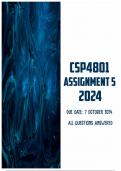, PLEASE USE THIS DOCUMENT AS A GUIDE TO ANSWER YOUR ASSIGNMENT
Please note that the author of this document will not responsibility for any plagiarizing you
commit.
A scholar and researcher called Sugata Mitra worked on a project called Self-Organised Learning
Environments (SOLEs) and on the School in The Cloud.
The basic idea for SOLEs, is for the learners to work in a group of four (they choose their groups) on a
single complex question. Each group needs an internet-enabled laptop to do the work. The groups are
given a question such as “Why do we slip on wet surfaces?” or “Do trees breathe?” The learners are
asked to give a presentation as a report back after a given time. Other than the instruction and the
computers, they are largely left to answer the question on their own.
The following PDF contains more information on what a SOLE is and how it can become a
reality in classrooms:
https://centroderecursos.educarchile.cl/bitstream/handle/20.500.12246/56116/sole-toolkit-sugata-mitra.
pdf?sequence=1&isAllowed=y
1. Critically analyse this type of teaching, learning and curriculum. Include the following as part
of your analysis:
Briefly summarise the main aspects of SOLE activities.
Provide both advantages and disadvantages (strengths and weaknesses) of the SOLE
activities. Include both teachers and learners in your discussion.
At the end of your analysis, provide a recommendation for adjusting this type of activity to
suit your school or subject.
Clarity, organisation, use of sources.
Introduction
Sugata Mitra's Self-Organised Learning Environments (SOLEs) represent a paradigm shift in
educational philosophy, where traditional teacher-led instruction is replaced by student-driven
inquiry. SOLEs empower students to explore complex questions in small groups using
internet-enabled devices, fostering autonomy, collaboration, and critical thinking. This approach
aligns with the broader concept of the "School in the Cloud," where students from diverse
backgrounds can access knowledge and resources online, irrespective of geographical and economic
barriers. The following analysis delves into the key aspects of SOLE activities, evaluates their
strengths and weaknesses, and offers recommendations for tailoring this innovative model to specific
educational contexts.
A Summary of Main Aspects
Self-Organised Learning Environments (SOLEs) represent a transformative approach to education,
driven by the idea that students can effectively guide their own learning when provided with the right
tools and environment. Developed by Sugata Mitra, this model challenges traditional
teacher-centered instruction by placing students at the center of their learning process. In a SOLE,
students work collaboratively to explore complex, open-ended questions, using internet-enabled
devices as their primary research tool. This approach fosters a range of skills, from critical thinking
and problem-solving to collaboration and self-regulation. To provide a comprehensive understanding
of SOLE activities, the following sections detail their main components, including the underlying




